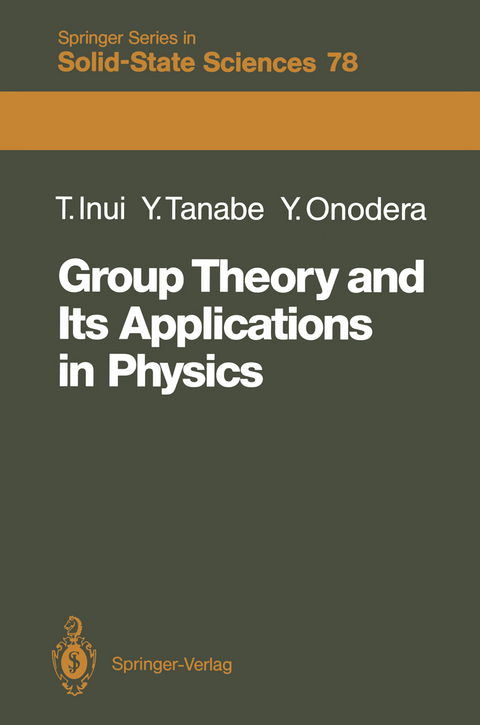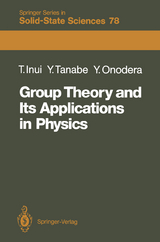Group Theory and Its Applications in Physics
Springer Berlin (Verlag)
978-3-540-60445-7 (ISBN)
Dieses Lehrbuch bietet eine sorgfältige Einführung in das Gebiet der Gruppentheorie und deren Anwendung in der Physik. Systematisch ausgearbeitete Beispiele aus der Atom-, Molekular- und Festkörperphysik sowie Übungen mit Hinweisen regen zum Selbststudium an. Die Aufnahme von weiterführendem Material macht das Buch zusätzlich für Wissenschaftler interessant.
This book has been written to introduce readers to group theory and its ap plications in atomic physics, molecular physics, and solid-state physics. The first Japanese edition was published in 1976. The present English edi tion has been translated by the authors from the revised and enlarged edition of 1980. In translation, slight modifications have been made in. Chaps. 8 and 14 to update and condense the contents, together with some minor additions and improvements throughout the volume. The authors cordially thank Professor J. L. Birman and Professor M. Car dona, who encouraged them to prepare the English translation. Tokyo, January 1990 T. Inui . Y. Tanabe Y. Onodera Preface to the Japanese Edition As the title shows, this book has been prepared as a textbook to introduce readers to the applications of group theory in several fields of physics. Group theory is, in a nutshell, the mathematics of symmetry. It has three main areas of application in modern physics. The first originates from early studies of crystal morphology and constitutes a framework for classical crystal physics. The analysis of the symmetry of tensors representing macroscopic physical properties (such as elastic constants) belongs to this category. The sec ond area was enunciated by E. Wigner (1926) as a powerful means of handling quantum-mechanical problems and was first applied in this sense to the analysis of atomic spectra. Soon, H.
Group Theory and Its Applications in Physics presents a careful introduction to this field. Worked examples, taken from atomic, molecular and solid-state physics, and exercises with hints and answers encourage self-study. The inclusion of some advanced material will make the book also of interest to professionals.
1. Symmetry and the Role of Group Theory.- 1.1 Arrangement of the Book.- 2. Groups.- 2.1 Definition of a Group.- 2.1.1 Multiplication Tables.- 2.1.2 Generating Elements.- 2.1.3 Commutative Groups.- 2.2 Covering Operations of Regular Polygons.- 2.3 Permutations and the Symmetric Group.- 2.4 The Rearrangement Theorem.- 2.5 Isomorphism and Homomorphism.- 2.5.1 Isomorphism.- 2.5.2 Homomorphism.- 2.5.3 Note on Mapping.- 2.6 Subgroups.- 2.7 Cosets and Coset Decomposition.- 2.8 Conjugate Elements; Classes.- 2.9 Multiplication of Classes.- 2.10 Invariant Subgroups.- 2.11 The Factor Group.- 2.11.1 The Kernel.- 2.11.2 Homomorphism Theorem.- 2.12 The Direct-Product Group.- 3. Vector Spaces.- 3.1 Vectors and Vector Spaces.- 3.1.1 Mathematical Definition of a Vector Space.- 3.1.2 Basis of a Vector Space.- 3.2 Transformation of Vectors.- 3.3 Subspaces and Invariant Subspaces.- 3.4 Metric Vector Spaces.- 3.4.1 Inner Product of Vectors.- 3.4.2 Orthonormal Basis.- 3.4.3 Unitary Operators and Unitary Matrices.- 3.4.4 Hermitian Operators and Hermitian Matrices.- 3.5 Eigenvalue Problems of Hermitian and Unitary Operators.- 3.6 Linear Transformation Groups.- 4. Representations of a Group I.- 4.1 Representations.- 4.1.1 Basis for a Representation.- 4.1.2 Equivalence of Representations.- 4.1.3 Reducible and Irreducible Representations.- 4.2 Irreducible Representations of the Group C?v.- 4.3 Effect of Symmetry Transformation Operators on Functions.- 4.4 Representations of the Group C3v Based on Homogeneous Polynomials.- 4.5 General Representation Theory.- 4.5.1 Unitarization of a Representation.- 4.5.2 Schur's First Lemma.- 4.5.3 Schur's Second Lemma.- 4.5.4 The Great Orthogonality Theorem T.- 4.6 Characters.- 4.6.1 First and Second Orthogonalities of Characters.- 4.7 Reduction ofReducible Representations.- 4.7.1 Restriction to a Subgroup.- 4.8 Product Representations.- 4.8.1 Symmetric and Antisymmetric Product Representations.- 4.9 Representations of a Direct-Product Group.- 4.10 The Regular Representation.- 4.11 Construction of Character Tables.- 4.12 Adjoint Representations.- 4.13 Proofs of the Theorems on Group Representations.- 4.13.1 Unitarization of a Representation.- 4.13.2 Schur's First Lemma.- 4.13.3 Schur's Second Lemma.- 4.13.4 Second Orthogonality of Characters.- 5. Representations of a Group II.- 5.1 Induced Representations.- 5.2 Irreducible Representations of a Group with an Invariant Subgroup.- 5.3 Irreducible Representations of Little Groups or Small Representations.- 5.4 Ray Representations.- 5.5 Construction of Matrices of Irreducible Ray Representations.- 6. Group Representations in Quantum Mechanics.- 6.1 Symmetry Transformations of Wavefunctions and Quantum-Mechanical Operators.- 6.2 Eigenstates of the Hamiltonian and Irreducibility.- 6.3 Splitting of Energy Levels by a Perturbation.- 6.4 Orthogonality of Basis Functions.- 6.5 Selection Rules.- 6.5.1 Derivation of the Selection Rule for Diagonal Matrix Elements.- 6.6 Projection Operators.- 7. The Rotation Group.- 7.1 Rotations.- 7.2 Rotation and Euler Angles.- 7.3 Rotations as Operators; Infinitesimal Rotations.- 7.4 Representation of Infinitesimal Rotations.- 7.4.1 Rotation of Spin Functions.- 7.5 Representations of the Rotation Group.- 7.6 SU(2), SO(3) and O(3).- 7.7 Basis of Representations.- 7.8 Spherical Harmonics.- 7.9 Orthogonality of Representation Matrices and Characters.- 7.9.1 Completeness Relation for XJ(?).- 7.10 Wigner Coefficients.- 7.11 Tensor Operators.- 7.12 Operator Equivalents.- 7.13 Addition of Three Angular Momenta;Racah Coefficients.- 7.14Electronic Wavefunctions for the Configuration (nl)x.- 7.15 Electrons and Holes.- 7.16 Evaluation of the Matrix Elements of Operators.- 8. Point Groups.- 8.1 Symmetry Operations in Point Groups.- 8.2 Point Groups and Their Notation.- 8.3 Class Structure in Point Groups.- 8.4 Irreducible Representations of Point Groups.- 8.5 Double-Valued Representations and Double Groups.- 8.6 Transformation of Spin and Orbital Functions.- 8.7 Constructive Derivation of Point Groups Consisting of Proper Rotations.- 9. Electronic States of Molecules.- 9.1 Molecular Orbitals.- 9.2 Diatomic Molecules: LCAO Method.- 9.3 Construction of LCAO-MO: The ?-Electron Approximation for the Benzene Molecule.- 9.3.1 Further Methods for Determining the Basis Sets.- 9.4 The Benzene Molecule (Continued).- 9.5 Hybridized Orbitals.- 9.5.1 Methane and sp3-Hybridization.- 9.6 Ligand Field Theory.- 9.7 Multiplet Terms in Molecules.- 9.8 Clebsch - Gordan Coefficients for Simply Reducible Groups and the Wigner-Eckart Theorem.- 10. Molecular Vibrations.- 10.1 Normal Modes and Normal Coordinates.- 10.2 Group Theory and Normal Modes.- 10.3 Selection Rules for Infrared Absorption and Raman Scattering.- 10.4 Interaction of Electrons with Atomic Displacements.- 10.4.1 Kramers Degeneracy.- 11. Space Groups.- 11.1 Translational Symmetry of Crystals.- 11.2 Symmetry Operations in Space Groups.- 11.3 Structure of Space Groups.- 11.4 Bravais Lattices.- 11.5 Nomenclature of Space Groups.- 11.6 The Reciprocal Lattice and the Brillouin Zone.- 11.7 Irreducible Representations of the Translation Group....- 11.8 The Group of the Wavevector k and Its Irreducible Representations.- 11.9 Irreducible Representations of a Space Group.- 11.10 Double Space Groups.- 12. Electronic States in Crystals.- 12.1 Bloch Functions and E(k)Spectra.- 12.2 Examples of Energy Bands: Ge and TIBr.- 12.3 Compatibility or Connectivity Relations.- 12.4 Bloch Functions Expressed in Terms of Plane Waves.- 12.5 Choice of the Origin.- 12.5.1 Effect of the Choice on Bloch Wavefunctions.- 12.6 Bloch Functions Expressed in Terms of Atomic Orbitals.- 12.7 Lattice Vibrations.- 12.8 The Spin-Orbit Interaction and Double Space Groups.....- 12.9 Scattering of an Electron by Lattice Vibrations.- 12.10 Interband Optical Transitions.- 12.11 Frenkel Excitons in Molecular Crystals.- 12.12 Selection Rules in Space Groups.- 12.12.1 Symmetric and Antisymmetric Product Representations.- 13. Time Reversal and Nonunitary Groups.- 13.1 Time Reversal.- 13.2 Nonunitary Groups and Corepresentations.- 13.3 Criteria for Space Groups and Examples.- 13.4 Magnetic Space Groups.- 13.5 Excitons in Magnetic Compounds; Spin Waves.- 13.5.1 Symmetry of the Hamiltonian.- 14. Landau's Theory of Phase Transitions.- 14.1 Landau's Theory of Second-Order Phase Transitions.- 14.2 Crystal Structures and Spin Alignments.- 14.3 Derivation of the Lifshitz Criterion.- 14.3.1 Lifshitz's Derivation of the Lifshitz Criterion.- 15. The Symmetric Group.- 15.1 The Symmetric Group (Permutation Group).- 15.2 Irreducible Characters.- 15.3 Construction of Irreducible Representation Matrices.- 15.4 The Basis for Irreducible Representations.- 15.5 The Unitary Group and the Symmetric Group.- 15.6 The Branching Rule.- 15.7 Wavefunctions for the Configuration (nl)x.- 15.8 D(J) as Irreducible Representations of SU(2).- 15.9 Irreducible Representations of U(m).- Appendices.- A. The Thirty-Two Crystallographic Point Groups.- B. Character Tables for Point Groups.- Answers and Hints to the Exercises.- Motifs of the Family Crests.- References.
| Erscheint lt. Verlag | 1.3.1996 |
|---|---|
| Reihe/Serie | Springer Series in Solid-State Sciences |
| Zusatzinfo | XV, 397 p. |
| Verlagsort | Berlin |
| Sprache | englisch |
| Maße | 155 x 235 mm |
| Gewicht | 664 g |
| Themenwelt | Naturwissenschaften ► Physik / Astronomie ► Allgemeines / Lexika |
| Naturwissenschaften ► Physik / Astronomie ► Atom- / Kern- / Molekularphysik | |
| Naturwissenschaften ► Physik / Astronomie ► Festkörperphysik | |
| Naturwissenschaften ► Physik / Astronomie ► Theoretische Physik | |
| Technik ► Maschinenbau | |
| Schlagworte | group theory • Gruppe (Mathematik) • HC/Mathematik/Geometrie • HC/Physik, Astronomie/Allgemeines, Lexika • Mathematical Physics • phase transition • Quantentheorie • Quantum Physics • solid-state physics • Spectra |
| ISBN-10 | 3-540-60445-6 / 3540604456 |
| ISBN-13 | 978-3-540-60445-7 / 9783540604457 |
| Zustand | Neuware |
| Haben Sie eine Frage zum Produkt? |
aus dem Bereich




